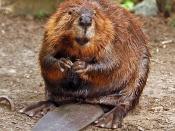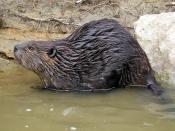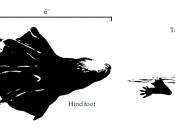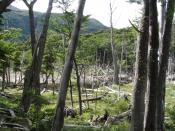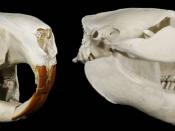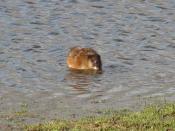AMERICAN BEAVER The latin name for the American beaver is castor canadiensis. It is usually 25 - 30 inches in length and has a 9 - 10 inch tail, which is about 6 inches wide and shaped like a paddle. Its weight can range from 30 to 60 pounds, and its body is covered with a rich brown-colored fur. The beaver, which can live about 11 years in the wild, is nocturnal and usually appears just after sunset swimming near its dam, which can be found in almost any shallow area of freshwater. This mammal is perfectly designed for the water with its thick, waterproof fur, chunky body, and an extra layer of fat just under the fur. All of these factors help to minimize the loss of body heat in the icy water. It has a transparent eyelid to protect each eye underwater, and its nose and ear openings can be closed while the animal is submersed.
The respiratory and circulatory systems of the beaver are slightly adapted to increase efficiency, and its powerful, flat tail; large, webbed feet; and strong hind legs further enhance its underwater swimming abilities.
The American beaver uses its huge front teeth to gnaw through smaller trees, such as aspen, willow, birch, alder, poplar, and maple, in order to fell them to strip them of bark and eat the growing or cambial layer of tissue under the bark. The beaver will create a winter food cache by dragging some of these trees to an underwater storage area. It also eats twigs, buds, and roots, but aspen and willow are definitely the preferred food of the beaver. It never strays from its vegetarian diet and may even travel quite far from water to find its favorite food. When a rich food source is discovered, the colony may work together to dig canals to facilitate the transportation of the logs and branches to the beaver dams.
The American beaver is one of the few other animals besides human beings that significantly change the environment. Not only does the beaver dig canals, which affect natural water levels, and cut down trees along the banks of rivers, lakes, and ponds, but it also builds its dam across slow rivers and streams. This causes the watertable to rise, allowing more vegetation to grow, which, in turn, feeds more animals.
